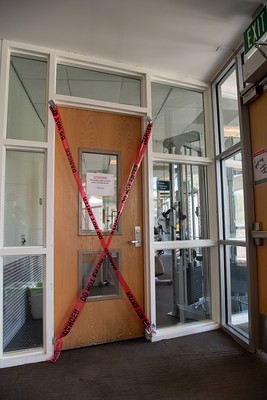A recently published paper models the spread of COVID-19 on a hypothetical campus of 20,000 students. For the purposes of the model, the researchers made a few assumptions. First, they assumed that the average class size was 24 people. 90% of the classes on the model campus were under 50 people. Finally, 2,500 instructors and 20,000 students met for a 100 day semester. They also assumed a one-in-four chance of one previously uninfected person becoming infected off-campus, before bringing the virus to campus.
Jennifer Peck and Philip Gressman, professors at Swarthmore and The University of Pennsylvania respectively, authored the paper. Their model shows that without any significant measures in place to prevent the spread of COVID-19, the campus would achieve peak infection in 20-40 days. By the 100th day, every campus community member in the model was infected.
On the other hand, when the model university employed standard interventions – like quarantining compromised individuals, contact tracing, strict usage of face coverings, daily testing of 3 percent of the university population (675 people) and moving above-average sized classes online, the model showed a semester-long infection rate of fewer than 66 people 95% of the time.
The researchers tweaked the assumptions they’d made, including those of testing accuracy. With highly accurate testing, and retesting individuals who produced one positive result, the researchers found that they could reduce the number of individuals in quarantine while maintaining low overall infection rates.
Managing COVID-19 requires more of both the College and its students
Based on the modeling, the researchers offered the following conclusion:
“All instructors need to prepare for extended student absences due to quarantine. In our best-case scenario, classes spend an average of 1-2 weeks of the semester with at least 10% of the students absent due to quarantine. For this reason, we expect that even small classes which are permitted to meet in person will still need procedures in place for continuity of instruction for quarantined students.”
They also found that to keep the infection rates as low as possible, students needed to avoid all contact with others outside of either an academic or residential setting. Even seemingly insignificant contacts – in dining spaces or at parties – could drive infection rates on campus higher, despite all known effective protective measures. Further, no iterations of the model were successful when large classes were conducted in person.
Part of the reason this is true is that real-world data shows that each student has contact with about 1.2% of the entire student body
In WCC’s case, with a campus population of 11,500 students, each student has contact with nearly 140 people. When you factor in secondary contact – all the classmates of one student’s classmates – that contact figure rises to 50%. It’s not hard to see why disease spreads quickly without interventions.
Surveillance testing is essential
One key part of the model includes surveillance testing of 3% of the campus population each day. WCC’s COVID-19 Preparation and Response plan does not include any testing at all. In fact, WCC has not created any testing capability for its on-campus population.
Testing is critical to detecting the appearance and spread of disease on campus. As many as half of all people infected with COVID-19 have no symptoms. These carriers could spread disease for days without showing any signs of illness. Further, all WCC students leave campus at night. Unlike the model, there is no way to restrict a student’s contact to the academic and residential settings.
WCC makes an ideal testing space because data show that most asymptomatic carriers are young people between the ages of 20-40. Unfortunately, WCC’s COVID-19 plan makes no provisions for the identification and management of asymptomatic carriers.
Further, WCC’s plan to manage reports of infection on campus include closing spaces where an infected person has been for 24 hours before cleaning it. This will quickly become untenable when multiple people in multiple locations contract the disease.
WCC needs to take a more realistic approach to the management of COVID-19 on campus. Managing the disease carefully where students gather, and certain staff must report can help reduce its spread in the community.
Photo Credit: National Renewable Energy Lab , via Flickr













